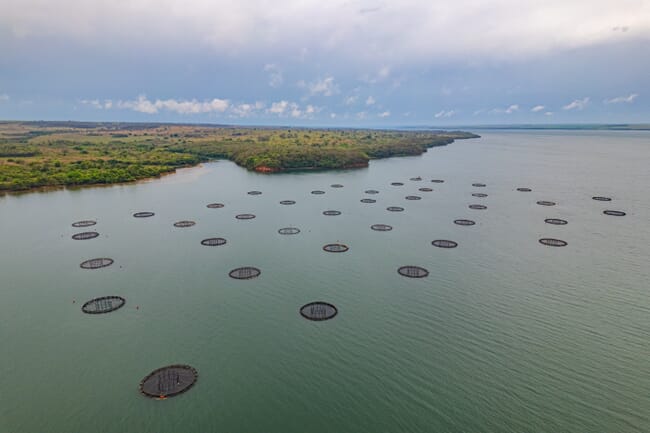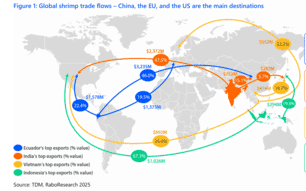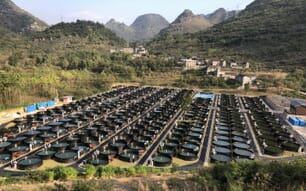
© Rabobank
According to the bank’s newly-published Global Aquaculture Outlook 2026 – which is based largely on the Global Seafood Alliance’s annual producers’ survey – next year is likely to see high production coupled with high prices and comparatively low costs.
The report forecasts a strong year for carp species, with a 6 percent year-on-year growth – and lead author Gorjan Nikolik attributes this largely to China’s drive to become more self-sufficient in food production, as carp require on a very low percentage of imported soy in their diets.
Meanwhile seabass and sea bream are expected to increase by 4 percent, shrimp and tilapia by 3 percent and both pangasius and salmon by 2 percent.
Atlantic salmon: slower growth but higher margins
The Rabobank report notes that the Atlantic salmon sector, which enjoyed a sharp rebound in 2025, is poised for a “temporary deceleration” in 2026, as major producers normalise.
Norway, the world’s largest salmon producer, is expected to see a 0.9 percent decline in output in 2026, following an exceptional 11 percent rise in 2025. Rabobank attributes the slowdown to “the elevated production base set in 2025” and ongoing regulatory uncertainty, including debates surrounding the proposed aquaculture white paper.
Despite the slight contraction, biological performance in Norway continues to improve.
“Higher vaccination rates, expanded post-smolt strategies, and broader adoption of sea lice technologies are expected to mitigate potential headwinds,” the report notes.
In Chile, meanwhile, the rebound continues. Production is forecast to grow 5 percent in 2026 after an 8 percent surge in 2025, allowing the country to exceed its previous peak volume in 2020. Yet Rabobank warns that Chile’s heavy reliance on the US market leaves it exposed to soft consumer demand and currency fluctuations.
Scotland’s salmon sector is projected to record a 9 percent growth in 2026 after a 3 percent contraction in 2025, while the Faroe Islands is set to grow by 25 percent in 2025, putting the archipelago above Canada – which is suffering from regulatory uncertainty and warming waters in the Pacific – in global production terms, before stabilising to a 2-3 percent increase next year.
Iceland is expected to return to more normalised growth in 2026, with a projected increase of 3 percent, following a 21 percent expansion in 2025.
“We are having a really low supply now, and the negative supply will start in Q4 and last at least four quarters,” predicts Nikolik. “That is almost certainly going to recover the prices and we’re really looking forward to an excellent year of profitability, as costs will not increase at the same pace, so you can really expect an expansion of the profit margin.”

© RaboResearch and Kontali
Stabilisation for shrimp
Rabobank expects shrimp markets to move toward equilibrium after two volatile years and forecasts that global shrimp aquaculture will grow 3 percent annually in both 2025 and 2026, with Ecuador cementing its dominance.
“Investments in processing capacity and improved feed formulations are positioning Ecuador to capture greater US market share,” the report states.
“Our predictions this time last year were wrong about Ecuador slowing down… now it looks like they’re growing by 10 to 15 percent [this year,]” Nikolik, explained to The Fish Site. And he expects them to continue to grow, albeit at a lower level – most likely by around 6 percent – in 2026.
Meanwhile Asia has been gradually regaining stability.
“Asia’s shrimp production has stabilized to low single-digit numbers,” the report states. India’s growth is forecast to slow sharply – from 5 percent in 2025 to 2 percent in 2026 – as the full impact of new US tariffs takes hold. Vietnam, facing persistent disease outbreaks and tighter margins, may see only 1 percent growth in 2026, following a 2 percent contraction in 2025.
By contrast, China is set for a notable rebound, with production expected to rise by 6 percent in 2026 thanks to large-scale inland farming expansion and hatchery consolidation. Rabobank describes this as a “phase of structural modernization” that could improve long-term competitiveness.
Meanwhile Mexico also continues to expand, supported by tariff-free US access and strong domestic demand.
An emerging trend across Asia is the renewed interest in black tiger shrimp (Penaeus monodon). Global monodon output is projected to grow 4 percent in 2025 and 6 percent in 2026 as farmers seek better profitability amid rising production costs for vannamei.
“Genetic improvements and expanding broodstock markets are improving access to domesticated, high-performing juveniles,” the report explains, particularly in India and Vietnam.
And the report notes that demand for shrimp has been much higher than anticipated, especially in Europe where sales increased by over 10 percent, despite the increase in prices.
“The sector has produced – and consumed – a lot of shrimp this year. It’s been incredible that we've managed to consume that much shrimp at that value,” Nikolik notes.
However, he expects demand to reduce in 2026 due to factors including US import tariffs, and the decision of many US distributors to stockpile consdierable inventories of frozen shrimp before the tariffs kicked in.
“2026 will probably be weaker… competition between Ecuador and the Asians will get even more intense,” Nikolik predicts.

© Tilabras Tilapia
Tilapia: resilience despite trade turbulence
Tilapia – a cornerstone species for food security and emerging economies – continues to show resilience, despite the recent raft of US trade tariffs. Global production is expected to grow 3 percent in 2026, driven primarily by Southeast Asia, Africa and Latin America.
In Asia, Indonesia leads with 4 percent growth to 1.6 million tonnes, supported by “lower US tariffs and strong export competitiveness.” China’s production remains flat, with growth capped at 0–1 percent as producers pivot toward higher-value species such as grouper and pompano.
“High US tariffs and rising competition are pressuring margins and prompting farmers to shift toward higher-value species,” the report observes. This structural adjustment reflects a broader move in Chinese aquaculture toward diversification and domestic market alignment.
Africa’s tilapia industry is gaining momentum, led by Nigeria, where production is forecast to rise 29 percent in 2026 following an extraordinary 40 percent jump the previous year, due to “improved access to better genetics,” the report notes.
Zambia and Ghana are also on strong upward paths, expanding by 5 percent and 6 percent, respectively, supported by government-backed hatchery initiatives.
Latin America remains steady, with Brazil’s tilapia output set to increase by 2 percent in 2026 after surpassing the 500,000-tonne threshold. However, Rabobank flags that “rising costs and trade barriers – such as the 50 percent US import tax” may limit expansion. Mexico continues to perform strongly, with expected 11 percent growth, driven by robust domestic demand and ongoing intensification.
Pangasius to pass 4 million tonnes
The report suggests that pangasius production is set for modest growth in 2026, with an expected increase of 2 percent globally to surpass 4.1 million tonnes.
“Vietnam is set to lead this growth, with output rising by 6 percent in 2025 and 2 percent in 2026, nearing 2 million metric tonnes,” the report notes.
The sector’s near-term prospects are shaped by trade tensions and shifting US import duties. While a reduction in countervailing tariffs to 20 percent offers some relief, American buyers remain cautious amid high inventories.
India and Indonesia are also contributing to incremental gains, each expanding production between 3 percent and 4 percent. For some Indian farmers, pangasius can mitigate shrimp-related tariff risks, while in Indonesia, domestic consumption underpins growth.

© RaboResearch and Kontali
Marine finfish
2026 is looking promising for a number of marine finfish species, with overall production of sea bass and sea bream in the Mediterranean expected to expand by 4 percent, led by Turkey and Greece.
“Turkey, the region’s largest supplier, is projected to grow by 6 percent in 2026,” Rabobank reports, adding that sea bream production is expected to rebound strongly after three years of decline. Greece’s recovery mirrors this trend, with a 4 percent uptick following output stabilisation in 2025.
In Asia, China’s appetite to grow more premium marine finfish continues. “Consumer demand and profitability are driving momentum in China’s shift toward premium species,” the report highlights. Pompano and grouper are leading the way, growing 6–7 percent in 2026. Japanese sea bass and turbot are also on the rise, supported by government incentives and changing consumer preferences.
However, Rabobank cautions that “the move toward carnivorous species is likely to increase demand for fishmeal, where limited supply growth could constrain future expansion.”
Causes for economic optimism?
Despite ongoing volatility, Rabobank’s survey of producers from the Global Seafood Alliance’s network suggests that industry optimism has improved, with more respondents expecting stronger global markets, lower feed prices and better economic conditions.
“Market prices and disease prevention continue to be the top concern,” the report notes, but the sentiment shift is clear: producers are beginning to plan for moderate recovery.
The adoption of measures to improve sustainability is also accelerating. Between 2024 and 2025, the share of producers deploying animal welfare improvements rose from 59 percent to 79 percent, while 72 percent reported taking measures to reduce environmental impacts.
“A growing number of farmers are adopting sustainable practices and are being rewarded with premium pricing for their commitment,” Rabobank observes.
While 2026 may not bring the explosive growth of 2025, Rabobank’s outlook suggests the industry is entering a more stable, diversified phase. The rebalancing of trade flows, continued investment in premium species, and a clear shift toward sustainable production are reshaping the aquaculture landscape for the better.
As the report’s authors conclude: “The global aquaculture industry shows improved optimism for 2026 after a turbulent 2025.”
However, amid geopolitical uncertainty, anything could happen.








